Goerz 8x20 FaltmonokularDieses Goerz Faltmonokular zeigt die Bauweise des Zeiss Turmon. Schätzungsweise ist die Herstellungszeit auch um 1920-1935 (??). Das vorliegende Exemplar ist mit "8x20" oberhalb und der Seriennummer "9083" unterhalb des Prismenlogos, in dem sich der Firmennamen "C.P. Goerz Bratislava" (Preßburg) befindet, beschriftet. Die Beschriftung ist verblichen, scheint aber mit gelb-goldenen Buchtaben graviert gewesen zu sein (s. Foto 2). Die Linsentuben sind aus schwarz lackiertem Messing, die Prismenabdeckungen aus Leichtmetall mit Kunststoffüberzug (?). Am Objektivende ist ein silberner Metallring angeschraubt. Das zweite abgebildete Exemplar sieht nach einer Variante aus.Ein weiteres vorliegendes Exempalr hat die Seriennummer 5190. Rein äußerlich ähnelt es auch dem neueren MSP 5x25. |
Goerz 8x20 Folding MonocularThis Goerz folding monocular has the Zeiss Turmon design. The date of production can be estimated at about 1920 to 1935 (??). The first specimen depicted here is marked "8x20" over and with serial number 9083 under the Goerz prism logo. Inside the logo are the words "C.P. Goerz Bratislava". The inscript is faded, but seems to have been set with yellow golden letters (s. pic 2). The lens tubes are made of black painted brass, the prism covers made of light metal with some plastic covering (?). At the objective end, there is a silver metal ring screwed on. The second specimen depicted looks like a variant.Another 8x20has the serial number 5190. The outer appearance resembles the newer MSP 5x25. |
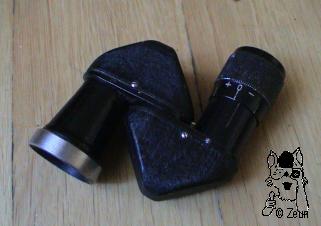
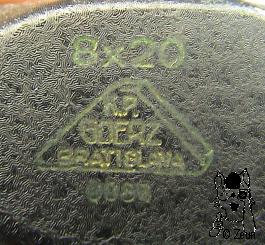
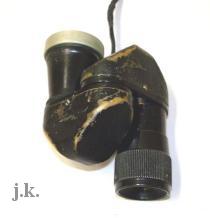
| Das Faltmonokular wiegt 74g. Ausgeklappt ist es 6cm lang, 6cm hoch (6,8cm bei ausgedrehtem Okular) und 19mm breit (Prismenabdeckungen). Das Okular hat einen Durchmesser von 21mm, das Objektiv 25mm. Es lässt sich zu beiden Richtungen um 90° drehen/falten und ist mit einem Anschlag (s. roter Pfeil Bild 4) versehen, so dass man immer ein 'rechte' Bild erreicht. | The folding monocular weighs 74g. Unfolded it is 6cm in length, 6cm in height (up to 6.8), and 19mm in width (prism covers). The eyepiece has a diameter of 21mm and the objective is 25mm. The prism body parts can be turned in a 90° angle to both sides beong stopped by a tiny pin (s. red arrow in pic 4), such always getting a 'right' image. |
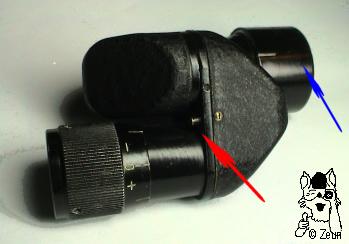
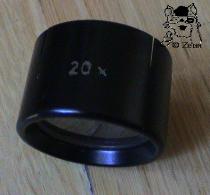
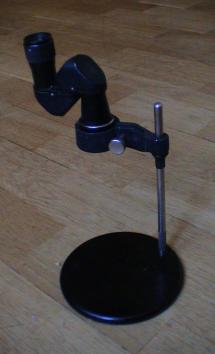
| Zu dem Monokular gab es, wie beim "Carl Zeiss Turmon" Vorsatzlinsen (hier: ein 20x; s. Bild 4 blauer Pfeil, Bild 5), so dass man es als Mikroskop (starker Nahfokus) nutzen konnte. Dafür gab es ein kleines Stativ mit Klammervorrichtung für die Vorsatzlinse, die auf das Objektiv gesteckt wurde. | There were also close-up/dioptre lenses available (cf. "Carl Zeiss Turmon" (here: a 20x lens; s. pic. 4 blue arrow a. pic. 5), so that you could use it as a microscope (near focus). A little holding device (monopod) was supplied for that use. It has a clamp to fix the dioptre lens which you can slipü on the objective or vice versa. |
Fotos: Zeun; 3. J. Kelly

